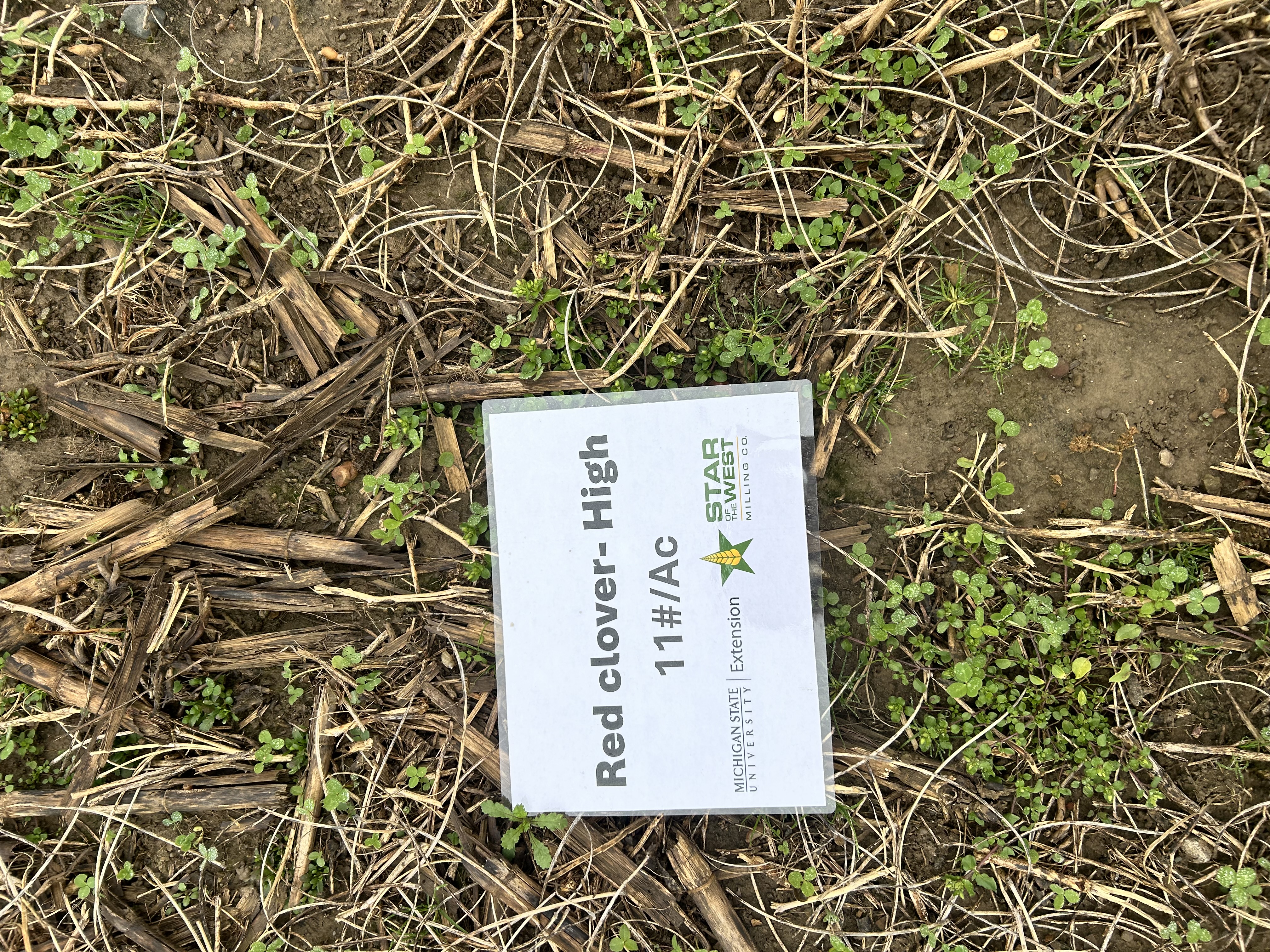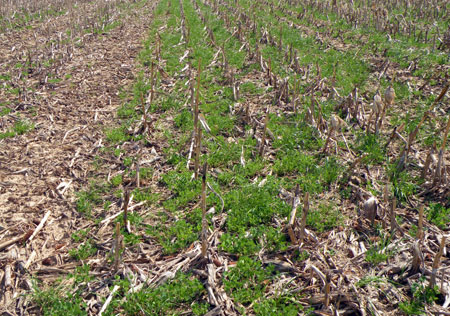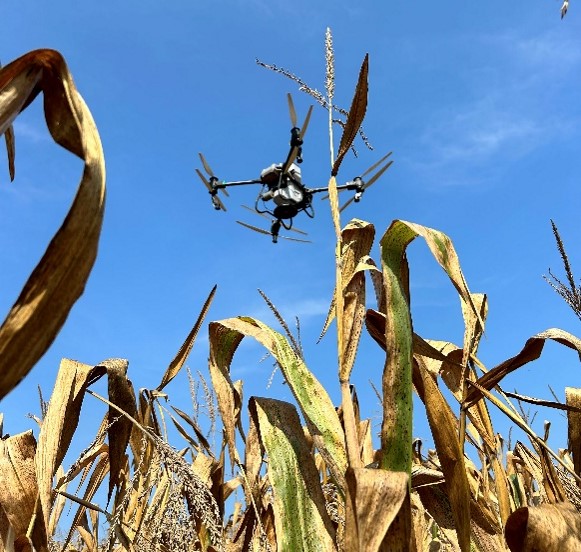Interseeding cover crops into corn and soybeans in Michigan: Lessons learned
Michigan farmers have found creative ways to get cover crops in earlier. Here are some interseeding tips we have learned from trial (and some error).

Establishing cover crops is not a new practice, but one that Michigan State University Extension is continuing to research due to weather, herbicide and equipment variations. With a short growing season, it can be difficult for Michigan farmers to get cover crops established. Cold temperatures and shorter days can limit post-harvest growth of cover crops. By interseeding cover crops into standing cash crops, farmers are able to get cover crops seeded earlier, which increases potential cover crop growth and takes cover crop seeding off the already long, post-harvest to-do list. In this article, we will focus on what we have learned from previous on-farm trials investigating interseeding and overseeding cover crops into standing soybean and corn in Michigan.
Interseeding cover crops timing
Early interseeding of cover crops in corn V3/V4 has no impact on corn yield, according to Brooker, A. et al, 2020. The crop canopy after V4 and before corn senescence will limit cover crop growth. Due to the early canopy closure and concerns about complications for harvest, it is not recommended to seed cover crops into soybean at this time.
Late interseeding (overseeding) is an additional option to seed cover crops in the first two weeks of September in corn that is just starting to turn or in soybeans just before leaf drop. At this timing, seed is surface broadcast. Because seed is not able to be drilled or incorporated into the soil, it is crucial to time seeding before rain.
Frost seeding clover could also be considered interseeding and is a time-tested method for growing consistently well-established red clover cover crop. If you grow wheat, frost seeding Medium red clover into established wheat is a great option.
Overseeding cover crops – species and seeding rates
This list is not exhaustive but a good foundation to start with to increase your chances of establishment success when overseeding into corn or soybeans in September. To look at more species and rates, Michigan State University Extension suggests exploring the Midwest Cover Crop Selector Tool, which ranks species for their compatibility with interseeding (late and early).
For seeding rates, use the rate recommended for aerial seeding or for broadcast without incorporation. To compensate for anticipated stand loss due to reduced seed to soil contact, interseeding rates should be higher than the seeding rate used for drilling or broadcasting with incorporation. Rates listed below are intended as single species seeding rates and should be adjusted when seeding multiple species in a cover crop mixture.
Grasses: annual ryegrass [18-22 pounds (lbs) pure live seed (PLS) per acre] and cereal rye (50-100 lbs PLS per acre) establish consistently when overseeded. A recent trial in southern Michigan tested cereal rye rates overseeded into corn and soybeans at 15 lbs per acre (in a mix with clover and radish), 35 lbs per acre and 70 lbs per acre. The 70 lbs per acre seeding rate, produced greater biomass and canopy cover than lower seeding rates at one of the two sites [2024 Western Lake Erie Basin (WLEB) trial]. Oats (35-70 lbs PLS per acre) can also establish well in the fall, though they generally will not overwinter.
Brassica: only oilseed radish has been tested in Michigan and can establish well in the fall but does not overwinter. Other small-seeded brassicas that may be suited for overseeding but have yet to be tested in Michigan trials include rapeseed and camelina.
Legumes: only crimson and red clover have been tested in overseeding trials in Michigan. While crimson and red clover have successfully established in previous early interseeding trials, successful clover establishment from overseeding is still elusive and highly dependent on September rainfall, according to Brooker, Renner, Basso, 2020.
A trial in Clinton County seeded crimson clover at 12 lbs. per acre with annual ryegrass on Aug. 8 into standing corn, which resulted in successful stand. Red clover overseeded in September in the 2024 WLEB trial did not successfully establish, likely due to dry seeding conditions and limited rainfall for three weeks following seeding.


Mixtures: overseeding multiple cover crop species can help achieve multiple goals. For example, radish offers quick fall growth scavenging fall soil nutrients. Annual ryegrass, on the other hand, grows slowly in the fall but can scavenge spring soil nutrients and protect the soil from spring erosion. To protect the soil in both fall and spring, seed 2 lbs PLS per acre radish with 10 lbs PLS per acre annual ryegrass. When seeding mixtures, single species seeding rates or grasses and brassicas should be cut by 30-50%. When seeding a legume in a mixture, keep the full single species seeding rate to maximize nitrogen fixation.
Overseeding equipment
Airplane and high clearance ground rigs are the typical methods for interseeding over crops at leaf drop/senescence. Unmanned aerial vehicles (UAVs) are a newer technology that is becoming more widely available. More research is currently being conducted to fully understand the pros and cons of each method.
Airplane: Airplanes are the fastest method to get cover crops seeded; however, not all fields are accessible by airplanes and airplanes have a limited accuracy of spread (some overspread and missed spots expected).
High clearance ground rig: High clearance sprayers can be modified to make a high clearance seeder. These can cover more acres per hour than drones, though you may run over some crop and field conditions can limit when you seed. There are also concerns about compaction by these rigs in wet conditions.
UAV: UAV use for spreading seed is becoming increasingly widespread. The startup cost of drones can be lower than a high clearance ground rig. The UAVs smaller swath and lower flight height mean UAVs have the potential to cover small and hard to reach fields. Applying seed is slower than airplanes, especially with cover crops that require higher seeding rates, like cereal rye.
The 2024 WLEB study found that there was up to 70% less growth from UAV seeded treatment compared to the airplane and high clearance ground rig (2024 WLEB trial). As a newer technology, further observation is required to understand best practices to get consistent and accurate coverage, especially with mixes with a range of seed sizes.

Drone seeding cover crops podcast part 1
Drone seeding cover crops podcast part 2
Herbicide options
Cash crop weed management is still important, whether or not you have a cover crop. Check out these resources to make sure the residual herbicides you are applying in your cash crop aren’t impacting your cover crop establishment. Important note: If using cover crops for forage, check herbicide labels for the grazing interval.
For early interseeding into corn, check out this bulletin outlining corn herbicide programs that can prevent herbicide carryover problems when seeding annual ryegrass or radish V3-V6.
For overseeding, Michigan State University has published research on early interseeding and on establishing cover crops after winter wheat harvest (E-434 Weed Control for Field Crops pages 171-172, 2025 edition). Michigan State University has not researched seeding grasses or Brassicas in the fall during leaf senescence or following soybean or corn harvest. North Dakota State University has tested the impact of some herbicide programs on cover crops seeded in September following corn silage harvest and in soybeans.
Corn: North Dakota State University researchers evaluated September seeded cover crop (cereal rye, red clover and winter camelina) tolerance to preemergence herbicides in corn field. The trials tested Outlook, Verdict and Resicore and found no impact on cover crop establishment.
Soybean: North Dakota State University researchers evaluated September seeded cover crop tolerance to both preemergent (soil applied) and postemergence herbicides in soybean fields. The trials tested nine different cover crops, five preemergent herbicides and four postemergence herbicides. The results are summarized in the following table.
Table 1. Risk of cover crop injury due to soybean herbicides with soil residual, Carrington and Fargo, 2016-20.1
| Site-years | Herbicide | Risk of cover crop injury | |||||||
|---|---|---|---|---|---|---|---|---|---|
| Barley | Winter Rye | Field Pea | Flax | Radish | Turnip | Lentil | Rapeseed/Canola | ||
| Soil | |||||||||
| 6 | Sencor 75 DF | Low | Low | Low | Low | Medium | Medium | Low | Low |
| 6 | Spartan 4F | Low | Low | Low | Low | High | Medium | Medium | Medium |
| 6 | Valor SX | Low | Low | Low | Low | High | High | Low | High |
| 6 | Zidua SC | Low | Low | Low | Low | Medium | Low | Low | Medium |
| 5 | Pursuit | Low | Low | Low | High | High | High | Low | Low |
| Post | |||||||||
| 5 | Engenia | Low | Low | Low | Low | Low | Low | Low | Low |
| 6 | Flexstar | Low | Low | Low | Low | High | Medium | Low | Medium |
| 2 | Liberty 280 | Low | Low | Low | Low | Low | Low | Low | Low |
| 2 | Raptor | Low | Low | Low | Low | Low | Low | Low | Low |
| 1 Low risk = 0-20% injury; Medium risk = 21-50% injury; and High risk = >50% injury. Greatest injury recorded for each treatment was used to determine risk level. | |||||||||
Late interseeding cover crops in soybean fields. North Dakota State University tested the impact of various soybean herbicide programs on cover crops seeded in early September. Cover crops were drilled into mowed soybean residue. This table summarizes results from 2018-2020 at two research sites in North Dakota. Source: NDSU research Report, 2020.
Tillage and interseeding
The 2024 WLEB overseeding trials and early interseeding trials conducted on farms across Michigan both included no-till sites, according to Brooker, Renner and Basso, 2020. The 2017-2018 early interseeding on-farm trials included both no-till and conventionally tilled sites and found that annual ryegrass and clover fall growth was better in conventionally tilled fields, likely because seed to soil contact was improved in fields with less residue.
Interseeding/overseeding overview
Frost seeding (late February, early March)
Equipment: fertilizer spreader, UAV
- Wheat- medium red or crimson clover
Early interseeding
Equipment: modified drill, airplane, fertilizer spreader, UAV
- Corn V3/V4
- annual ryegrass, cereal rye, oats, radish, crimson clover, red clover
Late interseeding (overseeding)
Equipment: airplane, drone, high clearance ground rig
- Soybean at leaf drop
- annual ryegrass, cereal rye, oats, radish
- Corn at crop senescence
- annual ryegrass, cereal rye, oats, radish



 Print
Print Email
Email